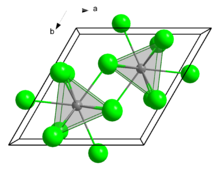
| |
| Names | |
|---|---|
| Other names
Actinium trichloride
Actinium chloride | |
| Identifiers | |
3D model (JSmol)
|
|
PubChem CID
|
|
| |
| |
| Properties | |
| AcCl3 | |
| Molar mass | 333.378 g/mol |
| Appearance | White crystalline solid |
| Density | 4.81 g/cm3 |
| Melting point | 1,051 °C (1,924 °F; 1,324 K) (sublimes) |
Except where otherwise noted, data are given for materials in their standard state (at 25 °C [77 °F], 100 kPa).
| |
Actinium(III) chloride is a chemical compound containing the rare radioactive element actinium. This salt has the formula AcCl3. Molecular weight of the compound is 333.378 g/mol.[2]
Synthesis[edit]
Actinium(III) chloride is made by reacting actinium hydroxide with carbon tetrachloride.[1]
- 4 Ac(OH)3 + 3 CCl4 → 4AcCl3 + 3CO2 + 6H2O
References[edit]
- ^ a b Ltd, Mark Winter, University of Sheffield and WebElements. "WebElements Periodic Table » Actinium » actinium trichloride". www.webelements.com.
{{cite web}}: CS1 maint: multiple names: authors list (link) - ^ Pubchem. "Actinium chloride". pubchem.ncbi.nlm.nih.gov.
Well, that’s interesting to know that Psilotum nudum are known as whisk ferns. Psilotum nudum is the commoner species of the two. While the P. flaccidum is a rare species and is found in the tropical islands. Both the species are usually epiphytic in habit and grow upon tree ferns. These species may also be terrestrial and grow in humus or in the crevices of the rocks.
View the detailed Guide of Psilotum nudum: Detailed Study Of Psilotum Nudum (Whisk Fern), Classification, Anatomy, Reproduction